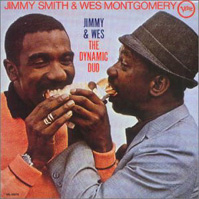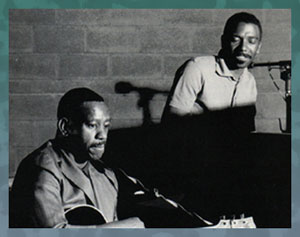

|
Soundclip:
|
|
Wes
Montgomery's Solo on:
"13"(Death March)(Gary McFarland) |
|
Recently, while traveling, I happened to hear "13"(Death March) from the first Jimmy Smith & Wes Montgomery recording titled, "JIMMY & WES - THE DYNAMIC DUO"(Verve). I was again struck by several elements which had always reached me about the tune and this performance: [1] Where Wes was concerned, just how melodic his solo was; [2] The opening phrase of Jimmy Smith's solo; and [3] The very unique arranging and orchestration style of the late and very great Oliver Nelson. So, as I had some time,  I decided that I would transcribe Wes' solo and share my impressions of this interesting tune by vibist-arranger-composer, Gary McFarland. Another element which caught my attention was that neither Wes nor Jimmy Smith participates in the statement of the melody, and neither artist plays a single chord during the exposition of the theme, highly unusual I decided that I would transcribe Wes' solo and share my impressions of this interesting tune by vibist-arranger-composer, Gary McFarland. Another element which caught my attention was that neither Wes nor Jimmy Smith participates in the statement of the melody, and neither artist plays a single chord during the exposition of the theme, highly unusualIt's also important to note the solo form which is used here. Both Jimmy Smith and Wes play three choruses but there's a 'catch' to the solo form. During the head there is essentially a 16-bar form which repeats, then at the end of the 2nd chorus there is a [Tag] added to give a 'rocket'(a launch) into the first solo. When you listen to Wes' solo, pay special attention to the bass because it outlines the changes so well. You'll hear, and see, that in bar 14 of the 1st chorus, there is a Gb7 chord played for soloing which NEVER appears during the 'head' of the tune. This chord ONLY appears during Chorus [1] of Wes' solo and never again! Choruses [2] and [3] employ an Fm7 in bar 14 each time and this is also what appears during the 'head' as well. I would be very curious to know how that Gb7 chord made it into the arrangement. It is also interesting to take note of the chord color used in bars 15-16 of each chorus. During the 'head,' in these bars it's very clear that the chord is treated as a Gm7(9) with a particular clustered voicing in the brass and woodwinds: spelling up you could simply have A-Bb-D with the 'A' being just below middle 'C.' However, during the solos, as both players are essentially performing without any chordal accompaniment(though in Wes' case, Smith comps very lightly behind him), they are free to interpret the color of this chord as they so choose. And BOTH players opt to treat the chord as if it's a 'G' altered dominant 7th chord to pull us back to the root, Cm7, even though there's a bit of a false cadence, and each chorus begins on the ivm7 chord, Fm7. Also, not contained within the statement of the melody is Oliver Nelson's addition of some changes during the 1st 8-bars of chorus [3]. It's a beautiful iim7-V7(alt.)-IMaj7 in EbMaj., then the remainder of the chorus is the same. I suppose that the lesson to be learned here is this: Just because a composition has been stated in a particular way, it does NOT mean that the form we use for soloing has to be the same! I believe that we should all endeavor to make the form and changes, over which we solo, have a sense of flow and logic. I'm not saying that we should make it 'easier' for ourselves, just that we make it more 'musical' if that is what seems to be necessary. The changes and form of any head should not be seen as being 'etched in stone!' Wes Montgomery's solo here is a masterpiece of economy and melodic continuity. Take special note of the first 8-bars of each chorus. He places a great deal of emphasis on the two pitches of 'C' and 'Eb' while employing a very bluesy feeling to everything. As there are three choruses to be played, Wes begins in Chorus [1] by using single-note lines, then in Chorus [2], he opens by adding octave punctuations(almost a "call & response" device), and finally, in Chorus [3] he solos in octaves, with the octaves speaking beautifully over Nelson's woodwind and brass textures. I would like to make note of Wes' treatment of the Am7b5 chord which appears in each chorus in bar 12. There are those who might argue that this particular chord is really an F7(9) with an 'A' in the bass, especially because Cm7-F7 is such a familiar chord movement. From a modal standpoint, as I view things, you might expect to see C-dorian employed here, but it's fascinating to see/hear some Gb's as well as an Ab. Perhaps the ear 'accepts' such things because the chord is leading to an Ab7(13) which contains both pitches previously mentioned? And, if we are to conclude that we're really in the 'key' of Cm, then the Gb would seem to simply be a 'blue note.' In the end, as with all such things, YOUR EAR MUST BE THE JUDGE of what is "right" or "wrong!" Wes' approach to bars 15-16 in the first two choruses should be noted as well. In chorus [1] he clearly treats the chord as a 'G' altered dominant 7th chord, and utilizes notes which would indicate that he's hearing C harmonic minor(C, D, Eb, F, G, Ab, B-natural), within this tune, part of a 'false cadence' wanting to go to Cm, but actually leading to the ivm7(Fm7) as we alluded to earlier.  In chorus [2], Wes employs an E-natural which should NOT work if were we going back to Cm7, but here, because there really aren't clear chords outlined, it works. In chorus [2], Wes employs an E-natural which should NOT work if were we going back to Cm7, but here, because there really aren't clear chords outlined, it works.
There are two great double-time lines Wes played during this solo, one tremendously syncopated line appears in bars 9-10 of chorus [2] over the Bbm7 chord. A truly great passage as it's so difficult to execute rhythmically. He also plays a nice double-time passage in bars 15-16 of chorus [1]. I mention these moments in particular because it's so important for each of us to develop a sense of RHYTHMIC SELF-CONFIDENCE. That feeling, within oneself, that you could execute any line you might hear while improvising, or that you might be presented with in interpreting someone else's music. When trying to develop this, it is not a bad idea to have a metronome on, at home during practice time, when you're just using your imagination and improvising. Then, as you play, just attempt the ideas you HEAR and see how they come out rhythmically. Obviously, you can do the same things when you're making music with friends or at jam sessions. Once again, it's been my pleasure to share with you another Wes Montgomery solo. Though the Verve and A&M years were Wes' most successful, these recordings, other than "SMOKIN' AT THE HALF NOTE"(Verve), were not highly regarded by music critics and serious fans alike. Still, the melodic grace and beauty, the maturity of Wes' improvisations must never be discounted. He remains, in all settings, a brilliant, very special and enduring artist. And, as we are rarely now afforded the luxury of hearing our favorite artists in 'big band' settings, mostly due to budgetary considerations, please, enjoy Wes Montgomery here, with Jimmy Smith on organ, and the tremendous brass and woodwind textures of Oliver Nelson. It's a great treat for us all!
|